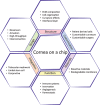Current and Future Cornea Chip Models for Advancing Ophthalmic Research and Therapeutics
- PMID: 39962012
- PMCID: PMC12264468
- DOI: 10.1002/adbi.202400571
Current and Future Cornea Chip Models for Advancing Ophthalmic Research and Therapeutics
Abstract
Corneal blindness remains a significant global health challenge, with limited treatment options due to donor tissue scarcity outside of the United States and inadequate in vitro models. This review analyzes the current state of cornea chip technology, addressing fundamental challenges and exploring future directions. Recent advancements in biomaterials and fabrication techniques are discussed that aim to recapitulate the complex structure and function of the human cornea, including the multilayered epithelium, organized stroma, and functional endothelium. The review highlights the potential of the cornea chips to revolutionize ocular research by offering more predictive and physiologically relevant models for drug screening, disease modeling, and personalized medicine. Current designs, their applications in studying drug permeability, barrier function, and wound healing, and their limitations in replicating native corneal architecture, are examined. Key challenges include integrating corneal curvature, basement membrane formation, and innervation. Applications are explored in modeling diseases like keratitis, dry eye disease, keratoconus, and Fuchs' endothelial dystrophy. Future directions include incorporating corneal curvature using hydraulically controlled systems, using patient-derived cells, and developing comprehensive disease models to accelerate therapy development and reduce reliance on animal testing.
Keywords: biofunctional membranes; cornea chip; cornea disease modeling; corneal curvature; drug screening; extracellular matrix; microfluidics; ophthalmology; organ chip; tissue engineering.
© 2025 The Author(s). Advanced Biology published by Wiley‐VCH GmbH.
Conflict of interest statement
The authors declare no conflict of interest.
Figures




Similar articles
-
Innovations in cancer treatment: evaluating drug resistance with lab-on-a-chip technologies.Int J Pharm. 2025 Sep 15;682:125936. doi: 10.1016/j.ijpharm.2025.125936. Epub 2025 Jul 5. Int J Pharm. 2025. PMID: 40623610 Review.
-
Prescription of Controlled Substances: Benefits and Risks.2025 Jul 6. In: StatPearls [Internet]. Treasure Island (FL): StatPearls Publishing; 2025 Jan–. 2025 Jul 6. In: StatPearls [Internet]. Treasure Island (FL): StatPearls Publishing; 2025 Jan–. PMID: 30726003 Free Books & Documents.
-
Nocardia Keratitis.2025 Jul 7. In: StatPearls [Internet]. Treasure Island (FL): StatPearls Publishing; 2025 Jan–. 2025 Jul 7. In: StatPearls [Internet]. Treasure Island (FL): StatPearls Publishing; 2025 Jan–. PMID: 31751092 Free Books & Documents.
-
Advances in Regenerative Medicine, Cell Therapy, and 3D Bioprinting for Corneal, Oculoplastic, and Orbital Surgery.Adv Exp Med Biol. 2025;1483:69-114. doi: 10.1007/5584_2025_855. Adv Exp Med Biol. 2025. PMID: 40131704 Review.
-
Ophthalmia Neonatorum.2025 Jul 7. In: StatPearls [Internet]. Treasure Island (FL): StatPearls Publishing; 2025 Jan–. 2025 Jul 7. In: StatPearls [Internet]. Treasure Island (FL): StatPearls Publishing; 2025 Jan–. PMID: 31855399 Free Books & Documents.
Cited by
-
Biological Barrier Models-on-Chips: A Novel Tool for Disease Research and Drug Discovery.Biosensors (Basel). 2025 May 26;15(6):338. doi: 10.3390/bios15060338. Biosensors (Basel). 2025. PMID: 40558420 Free PMC article. Review.
References
-
- Flaxman S. R., Bourne R. R. A., Resnikoff S., Ackland P., Braithwaite T., Cicinelli M. V., Das A., Jonas J. B., Keeffe J., Kempen J. H., Leasher J., Limburg H., Naidoo K., Pesudovs K., Silvester A., Stevens G. A., Tahhan N., Wong T. Y., Taylor H. R., Lancet Global Health 2017, 5, e1221. - PubMed
-
- Pineda R., Foundations of Corneal Disease: Past, Present and Future, In: Colby K., Dana R. (eds), Springer Nature, 2020, pp. 299–305, 10.1007/978-3-030-25335-6_25. - DOI
Publication types
MeSH terms
Grants and funding
LinkOut - more resources
Full Text Sources
Medical

